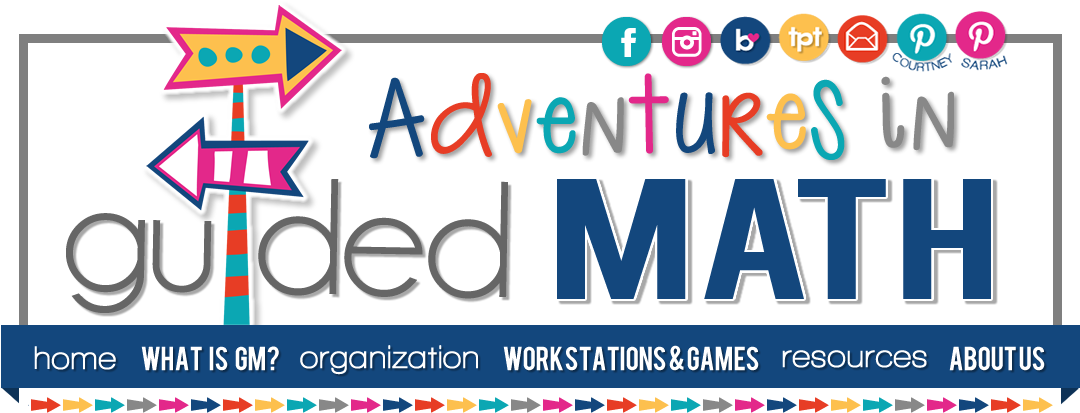Chapter 8 of Guided Math in Action is simply titled--What Are the Other Kids Doing?
If teachers want to meet in small guided math groups, then the rest of the kids must be engaged in meaningful tasks at their levels--tasks that can be completed without the help of the teacher. Dr. Nicki calls these independent activities math centers. Some teachers call them workstations.
Dr. Nicki begins by discussing some tips that will help math centers run smoothly in your classroom:
- Anchor charts should be hung around the room for easy reference during center time--outlining what students should be doing doing independent work time.
- Center storage needs to be easy, organized and durable and should include all materials needed.
- Math centers must be designed for independence allowing for work time alone, with partners, or in small groups.
- Students should be working on centers that are within their zone of proximal development.
Dr. Nicki goes on to suggest that students work within various groupings in a given week:
Individual Work:
- Students work on their own without a partner or group
- Groups of gathered in an area and working on the same task, but they are working on their own (parallel work)
- Collaborative Games--students work toward a common goal together (puzzles, matching games, etc.)
- Competitive Games--students play against one another to win
- Team Games--students pair up and play in teams, one pair against the other
Group Work:
- Collaborative Work--students work in groups with each person taking on a role (reader, number cruncher, checker, etc.)
- Competitive Games--students play games they are trying to win such as board games and card games
- Basic Fact Center--students practice basic facts with cards and sorts
- Hot Topics Review Center--students review skills they have work on during the year up to that point
- Geometry Center--students build and explore the attributes of shapes at more complex levels as the year goes on
- Word Problem Center--students explore problems at the concrete, pictorial, and abstract level
- Math Poem Center--students work with math poems, songs, and picture books (own versions of poems, class book, etc.)
- Math Journal Center--students explore concepts, work on projects, and grapple with mathematical ideas
- Math Vocabulary Center--students practice previous and new words (games, puzzles, flash cards, etc.)
- Use standard-based task cards
- Use scaffolded activity sheets
- Use leveled centers
- Hold students accountable
- Give feedback on center work
- Have students reflect on center work
Chapter 8 is chocked full of examples--student work, task cards, math center planning sheets, game ideas, and a sample schedule.
You might find some useful center/workstation ideas here:
Question 1:
My students often practice on their own and in pairs (including team games), yet I need to allow students to work more often in groups. I especially like Dr. Nicki's discussion of collaborative work and how she has students take on roles. While my students often work on problem solving tasks in pairs (sharing out within a small group), I can see the benefit of having students solve problems in small groups of 3-4 students as well. This will be a goal for my kids this year--the modeling of procedures and working together will be done to ensure their confidence and cooperation in a small group problem solving situation.
Question 2:
Students are held accountable for their work in several ways. As Dr. Nicki describes, my students have folders that they keep with them during center time. I look at student folders on occasion, but I like her idea of leaving students a little note (sticky notes would be great for this) when doing so. In the past, I have orally checked in with students, but I think they would enjoy finding periodic notes in their folders. :0) I also like Dr. Nicki's suggestion to have students share a piece of work from their folder at the end of math time, and I plan to add this in the mix next year. I do have a center called Show What You Know! This is a center where students are given a differentiated task/activity that must be completed on their own, and finished activity sheets are put in a drawer for me to look over. The majority of the time, I provide verbal feedback--grades are not given or taken. While this center provides some accountability, it's also an opportunity for a bit of ongoing assessment. My observations and questioning during work time, as well as conferences with students, are other ways my students are held accountable.
There's so much we could share about the math centers/workstations we use with our students---too much for one post! For this reason, we are kicking of our very first linky on Wednesday, August 13th--it's inspired by Chapter 8 of Guided Math in Action!
See the schedule of topics below, and stop back for the fabulous sharing that will be going on--and some FREEBIES, too! Have a blog and want to participate? Click the linky button on our sidebar to learn more!
SOME REMINDERS!
Click here if you have not read Dr. Nicki Newton's first of two Q & As!
Today is the last day for our Dr. Nicki Newton, Problem Solving with Models, giveaway! Click here to check out these awesome resources! The lucky winner will get to pick the grade level resource that best fits him/her. We will be randomly drawing the winner at the end of the day today! Good luck and have a fabulous week!








I enjoyed reading about Dr. Nicki's 7 must have centers. I already have ideas swarming around in my head on how to make it happen in my classroom.
ReplyDelete